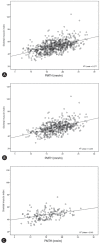Clinical usefulness of psoas muscle thickness for the diagnosis of sarcopenia in patients with liver cirrhosis
- PMID: 29706058
- PMCID: PMC6166111
- DOI: 10.3350/cmh.2017.0077
Clinical usefulness of psoas muscle thickness for the diagnosis of sarcopenia in patients with liver cirrhosis
Abstract
Background/aims: The most widely used method for diagnosing sarcopenia is the skeletal muscle index (SMI). Several studies have suggested that psoas muscle thickness per height (PMTH) is also effective for detecting sarcopenia and predicting prognosis in patients with cirrhosis. The aim of this study was to evaluate the optimal cutoff values of PMTH for detecting sarcopenia in cirrhotic patients.
Methods: All cirrhotic patients who underwent abdominal computed tomography (CT) scan including L3 and umbilical levels for measuring SMI and transverse psoas muscle thickness, respectively, were included. Two definitions of sarcopenia were used: (1) sex-specific cutoffs of SMI (≤52.4 cm2 /m2 in men and ≤38.5 cm2 /m2 in women) for SMI-sarcopenia and (2) cutoff of PMTH (<16.8 mm/m) for PMTH-sarcopenia.
Results: Six hundred fifty-three patients were included. The average age was 53.6 ± 10.2 years, and 499 patients (76.4%) were men. PMTH correlated well with SMI in both men and women (P<0.001). Two hundred forty-one (36.9%) patients met the criteria for SMI-sarcopenia. The best PMTH cutoff values for predicting SMI-sarcopenia were 17.3 mm/m in men and 10.4 mm/m in women, and these were defined as sex-specific cutoffs of PMTH (SsPMTH). The previously published cutoff of PMTH was defined as sex-nonspecific cutoff of PMTH (SnPMTH). Two hundred thirty (35.2%) patients were diagnosed with SsPMTH-sarcopenia, and 280 (44.4%) patients were diagnosed with SnPMTH-sarcopenia. On a multivariate Cox regression analysis, SsPMTH-sarcopenia (hazard ratio [HR], 1.944; 95% confidence interval [CI], 1.144-3.304; P=0.014) was significantly associated with mortality, while SnPMTH-sarcopenia was not (HR, 1.446; 95% CI, 0.861-2.431; P=0.164).
Conclusion: PMTH was well correlated with SMI in cirrhotic patients. SsPMTH-sarcopenia was an independent predictor of mortality in these patients and more accurately predicted mortality compared to SnPMTH-sarcopenia.
Keywords: Cirrhosis; Prognosis; Psoas muscle; Sarcopenia.
Conflict of interest statement
Figures




Comment in
-
Prognostic implications of trunk muscle mass in liver cirrhosis.Clin Mol Hepatol. 2018 Sep;24(3):297-298. doi: 10.3350/cmh.2018.0069. Epub 2018 Sep 10. Clin Mol Hepatol. 2018. PMID: 30196650 Free PMC article. No abstract available.
References
-
- Cruz-Jentoft AJ, Landi F, Topinková E, Michel JP. Understanding sarcopenia as a geriatric syndrome. Curr Opin Clin Nutr Metab Care. 2010;13:1–7. - PubMed
-
- Auyeung TW, Lee JS, Leung J, Kwok T, Woo J. The selection of a screening test for frailty identification in community-dwelling older adults. J Nutr Health Aging. 2014;18:199–203. - PubMed
-
- Tanimoto Y, Watanabe M, Sun W, Sugiura Y, Tsuda Y, Kimura M, et al. Association between sarcopenia and higher-level functional capacity in daily living in community-dwelling elderly subjects in Japan. Arch Gerontol Geriatr. 2012;55:e9–e13. - PubMed
-
- Woo J, Leung J, Sham A, Kwok T. Defining sarcopenia in terms of risk of physical limitations: a 5‐year follow‐up study of 3,153 Chinese men and women. J Am Geriatr Soc. 2009;57:2224–2231. - PubMed
MeSH terms
LinkOut - more resources
Full Text Sources
Other Literature Sources
Medical
Miscellaneous

